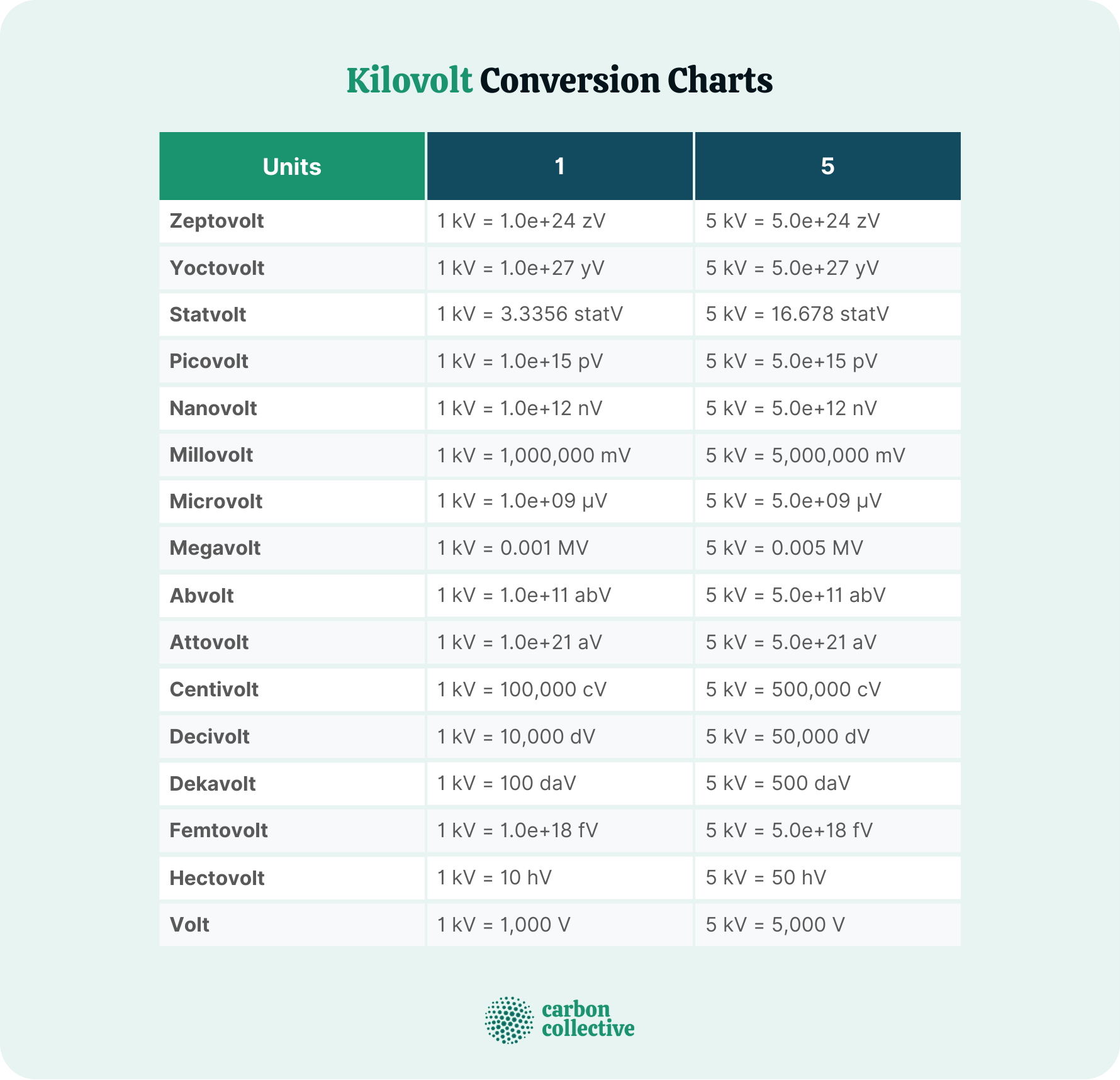What Is a Kilovolt?
A kilovolt (KV) is a unit of measurement for electric potential or voltage. It is defined as the potential difference between two points in an electric field that will cause a current of one ampere to flow through a resistance of one ohm.
In other words, a kilovolt measures how much electricity can be pushed through a circuit.
Volt is the base unit for a kilovolt. The prefix kilo comes from the Greek "chilioi", meaning a thousand. Kilo denotes a factor of 1,000, meaning there are 1,000 volts in a kilovolt.
The kilovolt often measures the voltage of high-voltage electrical systems. For example, kilovolts describe the power of an electric shock from a live wire.
How Does a Kilovolt Work?
A kilovolt works by quantifying the potential difference between two points in an electric field. This difference can cause a current to flow through a circuit.
It measures a high amount of voltage in an electrical system. The kilovolt is a multiple of the volt, the SI-derived unit for electric potential and voltage.
Kilovolt Applications
Kilovolts have various applications, including:
- Electric utilities use kilovolts to measure voltage in high-voltage transmission lines
- The kilovolt also describes the output of X-ray machines
- Kilovolts sometimes measure voltage in car batteries
- Kilovolts can measure electrostatic potential
- Kilovolts are a unit of measurement for DC power supplies
- Kilovolts are used in high-voltage capacitor banks
- Kilovolts can also measure electrochemical processes
Kilovolts vs Volts: Key Differences
Kilovolts and volts measure electric potential, but there are differences between the two.
One of the notable differences between kilovolts and volts is that kilovolts are multiple volts, meaning there are 1,000 volts in one kilovolt.
Kilovolts are sometimes abbreviated as kV, while volts are usually abbreviated as V.
Also, kilovolts are generally used in scientific settings, while volts are more commonly used in electrical engineering.
Lastly, kilovolts measure voltage in high-voltage transmission lines, while volts measure the voltage in low-voltage circuits.
Kilovolts vs Other Volts

(Source: CitizenMaths)
There are other units of voltage, such as megavolts and gigavolts.
Megavolts (MV) comprise one million volts, while gigavolts (GV) consist of one billion volts.
Kilovolts can also be converted into other units, such as millivolts (mV), microvolts (µV), and nanovolts (nV).
To convert kilovolts to millivolts, divide by 1,000. To convert kilovolts to microvolts, divide by 1,000,000. And to convert kilovolts to nanovolts, divide by 1,000,000,000.
The Bottom Line
Kilovolts are a unit of measurement for electric potential or voltage. They represent the potential difference between two points in an electric field that will cause a current of one ampere to flow through a resistance of one ohm.
In other words, kilovolts measure how much electricity can be pushed through a circuit. Kilovolts often measure the voltage of high-voltage electrical systems.
Kilovolts work by quantifying the potential difference between two points in an electric field. This potential difference can cause a current to flow through a circuit.
Applications of kilovolts include measuring voltage in high-voltage transmission lines and X-ray machines and measuring electrochemical processes.
Key differences between kilovolts and volts include kilovolts being a multiple of volts (1,000 volts in one kilovolt) and kilovolts generally being used in scientific settings, unlike volts, which have more common usages in electrical engineering.
Other units of voltage include megavolts and gigavolts. Megavolts are one million volts, and gigavolts are one billion volts. Kilovolts can also be converted into units, such as millivolts, microvolts, and nanovolts.
FAQs
1. What is a kilovolt?
A kilovolt is a unit of measurement for electric potential or voltage as the potential difference between two points in an electric field that will cause a current of one ampere to flow through a resistance of one ohm. In other words, kilovolts measure how much electricity can be pushed through a circuit.
2. What are kilovolts used for?
Applications of kilovolts include measuring voltage in high-voltage transmission lines and X-ray machines and measuring electrochemical processes. Kilovolts often measure the voltage of high-voltage electrical systems.
3. What is the difference between kilovolts and volts?
Key differences between kilovolts and volts include kilovolts being a multiple of volts (1,000 volts in one kilovolt) and kilovolts generally being used in scientific settings, unlike volts, which have more common usages in electrical engineering.
4. What are other units of voltage?
Other units of voltage include megavolts and gigavolts. Megavolts are one million volts, while gigavolts are one billion volts. Kilovolts can also be converted into units, such as millivolts, microvolts, and nanovolts.
5. How can kilovolts be converted into other units?
To convert kilovolts to millivolts, divide by 1,000. To convert kilovolts to microvolts, divide by 1,000,000. And to convert kilovolts to nanovolts, divide by 1,000,000,000. Kilovoltages can also be converted into other units, such as millivolts (mV), microvolts (µV), and nanovolts (nV).
